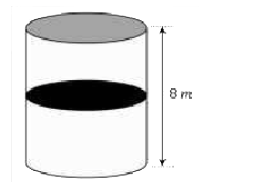Show a vertical cylindrical vesse seperated in two parts by a frictionless piston free to move along the length of vessel. The length of the cylilender is 90 cm and the piston divides the cylinder in the ratio of 5:4. Each of the two parts of the vessel contains 0.1 mole of an ideal gas. The temoerature of the gas is 300K in each part. Calculate the mass of the piston.(figure)
Let l1 and l2 be the lengths of the upper part and the lower part of the cylinder respectively. Clearly, l1 = 50cm and l2 = 40 cm. Let the perssures in the upper and lower parts be p1 and p2 respectively Let the area of coss- section of the cylinder be a. The temperature in both parts is T = 300 K.
Consider the equilibrium of the piston. The forces acting on the pistion are
(a) Its weight mg
(b) p1 a downward, by the upper part of the gas and (c) p2 a upward, by the lower part of the gas.
Thus, p2A=p1A+mg ...(i)<br>Usingp_(V) = nRTfortheupperandthelowerparts<br>p_(1)l_(1) A = nRT...(ii)<br>andp_(2)l_(2)A = nRT....(iii)<br>Pu∈gp_(1) Aandp_(2)Aom(ii)and(iii)∈→(i),<br>(nRT)/(l_2)= (nRT)/(l_1) + mg<br>Thus,m = (nRT)/(g)[(1)/(l_1)-(1)/(l_2)]<br>((0.1 mol)(8.3J//mol-K)(300K)/(9.8 m//s^2)[(1)/(0.4m)-(1)/(0.5m)]
=12.7 kg.
Topper's Solved these Questions
- BOOK - BANSALCHAPTER - KINETIC THEORY OF GASESEXERCISE - Practice Exercise3videos
KINETIC THEORY OF GASES
- BOOK - BANSALCHAPTER - KINETIC THEORY OF GASESEXERCISE - Exercise 141videos
KINETIC THEORY OF GASES
- BOOK - BANSALCHAPTER - KINETIC THEORY OF GASESEXERCISE - Section-B13videos
KINETIC THEORY OF GASES
- BOOK - BANSALCHAPTER - HEAT TRANSFEREXERCISE - Exercise89videos
HEAT TRANSFER
- BOOK - BANSALCHAPTER - UNIT DIMENSION, VECTOR & BASIC MATHSEXERCISE - Exercise10videos
UNIT DIMENSION, VECTOR & BASIC MATHS
Similar Questions
A thermally isolated cylindrical closed vessel of height 8 m is kept vertically . It is divided into two equal parts by a diathermic (perfect conductor) frictionless partition of mass 8.3 kg . Thus the partition is held initially at a distance of 4 m from the top , as shown in the schematic figure below . Each o the two parts of the vessel contians 0.1 mole of an ideal gas at temperature 300 K. The partition is now released and moves without any gas leaking from one part of the vessel to the other . When equilibrium is reached, the distance of the parition form one part of the vessel to the otehr . When equilibrium is reached the distacne of the partition from the top (in w) will be _______(take the accelearation due to gravity = 10 ms−2 and the universal gas constant =8.3J mol^(-1) K^(-1)).
 View Solution
View SolutionA vertical cylinder closed at both ends is divided into two parts by a frictionless piston, each part containing one mole of air. At 300K the volume of the upper part is 4 times of the lower part. At what temperature will the volume of the upper part be three times that of the lower part?
View Solution
Knowledge Check
- Question 1 - Select One
A vertical closed cylinder is separated into two parts by a frictionless piston of mass m and of negligible thickness. The piston is free to move along the length of the cylinder. The length of the cylinder above the piston is l1, and that below the piston is l2, such that l1>l2. Each part of the cylinder contains n moles of an ideal gas at equal temeprature T. If the pistion is stationary, its mass, m, will be given by : (R is universal gas constant and g is the acceleration due to gravitey)
ARTng[l1−3l2l1l2]BRTg[2l1+l2l1l2]CnRTg[1l2+1l1]DnRTg[l1−l2l1l2] - Question 2 - Select One
A vertical closed cylinder is separated into two parts by a frictionless piston of mass m and of negligible thickness. The piston is free to move along the length of the cylinder. The length of the cylinder above the piston is l1, and that below the piston is l2, such that l1>l2. Each part of the cylinder contains n moles of an ideal gas at equal temeprature T. If the pistion is stationary, its mass, m, will be given by : (R is universal gas constant and g is the acceleration due to gravitey)
ARTng[l1−3l2l1l2]BRTg[2l1+l2l1l2]CnRTg[1l2+1l1]DnRTg[l1−l2l1l2] - Question 3 - Select One
A vertical cylinder of height 1.52m is fitted with a movable piston of negligible mass and thickness. The lower half of the cylinder contains ideal gas and upper half is filled with Hg. The cylinder is initially at 300K. When the temperature is raised, half of the mercury comes out of cylinder. The temperature is: (Assume no thermal expansion for Hg)
A337.5KB364.5KC546KD600K
A line segment 56 cm long is to be divided into two parts in the ratio of 2:5. Find the length of each part.
View SolutionA vertical cylinder closed at both ends is divided into two parts by a frictionless piston, each part containing one mole of air. At 300K the volume of the upper part is 4 times of the lower part. At what temperature will the volume of the upper part be three times that of the lower part?
View SolutionA line segment 56cm long is to be divided into two parts in the ratio of 2 : 5. Find the length of each part.
View SolutionA 35-cm line segment is divided into two parts in the ratio 4:3. Find the length of each part.
View SolutionThe pressure of a gas contained in a cylinder with a movable piston is 300 Pa. The area of the piston is 0.5m2. Calculate the force that is exerted on the piston.
View Solution
